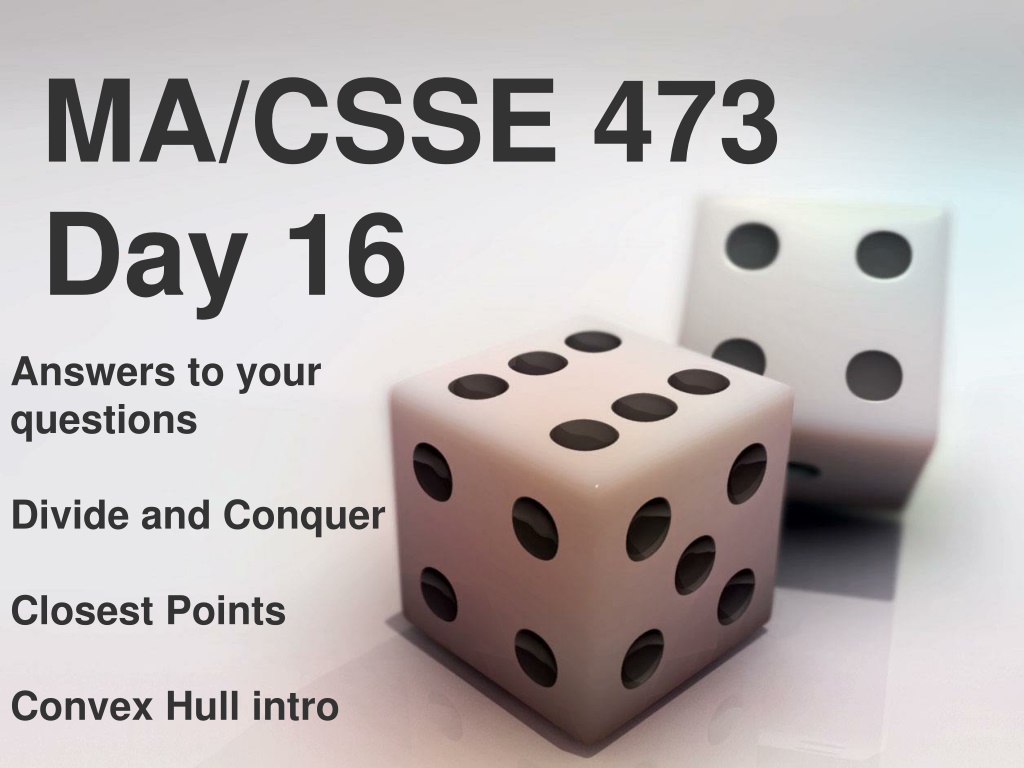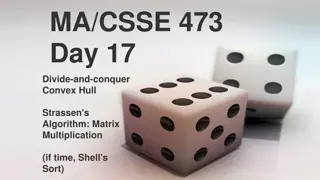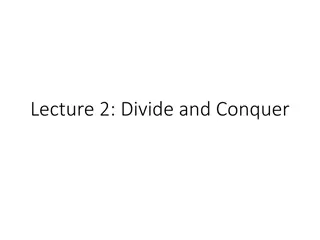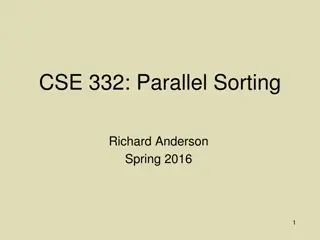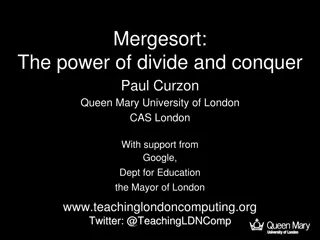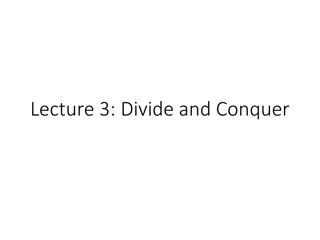Understanding Closest Points and Convex Hull in Divide and Conquer Algorithms
Exploring the divide-and-conquer approach to solving problems like finding the minimum distance between points on an xy-plane, and understanding concepts such as Gray Code and Hamiltonian Cycles in algorithm design. Dive into lexicographic permutations, efficient calculations, and examples seen in course material. Discover the intricacies of Hamiltonian cycles in undirected graphs and the application of divide-and-conquer algorithms in various scenarios.
Download Presentation

Please find below an Image/Link to download the presentation.
The content on the website is provided AS IS for your information and personal use only. It may not be sold, licensed, or shared on other websites without obtaining consent from the author. Download presentation by click this link. If you encounter any issues during the download, it is possible that the publisher has removed the file from their server.
E N D
Presentation Transcript
MA/CSSE 473 Day 16 Answers to your questions Divide and Conquer Closest Points Convex Hull intro
Exercise from last time Which permutation follows each of these in lexicographic order? 183647520 471638520 Try to write an algorithm for generating the next permutation, with only the current permutation as input. If the lexicographic permutations of the numbers [0, 1, 2, 3, 4, 5] are numbered starting with 0, what is the number of the permutation 14032? General form? How to calculate efficiency? In the lexicographic ordering of permutations of [0, 1, 2, 3, 4, 5], which permutation is number 541? How to calculate efficiently?
Gray Code and Hamiltonian Cycles A Hamiltonian cycle in an undirected graph is Hypercubes (picture is from Wikipedia): Binary-reflected Gray Code is a Hamiltonian Cycle of a Hypercube:
Divide-and-conquer algorithms Definition List examples seen in prior courses or so far in this course
Today: Closest Points, Convex Hull DIVIDE AND CONQUER ALGORITHMS
Divide-and-conquer algorithms Definition Examples seen prior to this course or so far in this course Q1
Closest Points problem Given a set, S, of N points in the xy-plane, find the minimum distance between two points in S. Running time for brute force algorithm? Next we examine a divide-and-conquer approach.
Closest Points "divide" phase S is a set of N points in the xy-plane For simplicity, we assume N = 2k for some k. (Otherwise use floor and ceiling functions) Sort the points by x-coordinate If two points have the same x-coordinate, order them by y-coordinate If we use merge sort, the worst case is (N log N) Let c be the median x-value of the points Let S1be {(x, y): x c}, and S2be {(x, y): x c} adjust so we get exactly N/2 points in each subset
Closest Points "conquer" phase Assume that the points of S are sorted by x- coordinate, then by y-coordinate if x's are equal Let d1 be the minimum distance between two points in S1 (the set of "left half" points) Let d2 be the minimum distance between two points in S2 (the set of "right half" points) Let d = min(d1, d2). Is d the minimum distance for S? What else do we have to consider? Suppose we needed to compare every point in S1 to every point in S2. What would the running time be? How can we avoid doing so many comparisons?
Reference: The Master Theorem The Master Theorem for Divide and Conquer recurrence relations: Consider the recurrence T(n) = aT(n/b) +f(n), T(1)=c, where f(n) = (nk) and k 0 , The solution is (nk) if a < bk (nk log n) if a = bk (nlogba) if a > bk For details, see Levitin pages 483-485 or Weiss section 7.5.3. Grimaldi's Theorem 10.1 is a special case of the Master Theorem. We will use this theorem often. You should review its proof soon (Weiss's proof is a bit easier than Levitin's).
After recursive calls on S1 and S2 d = min(d1, d2).
Convex Hull Problem Again, sort by x-coordinate, with tie going to larger y-coordinate.
Simplifying the Calculations We can simplify two things at once: Finding the distance of P from line P1P2, and Determining whether P is "to the left" of P1P2 The area of the triangle through P1=(x1,y1), P2=(x2,y2), and P3=(x3,ye) is of the absolute value of the determinant 1 y x y x x y 1 1 = + + 1 x y x y x y x y x y x y 2 2 1 2 3 1 2 3 3 2 2 1 1 3 1 3 3 For a proof of this property, see http://mathforum.org/library/drmath/view/55063.html How do we use this to calculate distance from P to the line? The sign of the determinant is positive if the order of the three points is clockwise, and negative if it is counter- clockwise Clockwise means that P3 is "to the left" of directed line segment P1P2 Speeding up the calculation
Efficiency of quickhull algorithm What arrangements of points give us worst case behavior? Average case is much better. Why?
